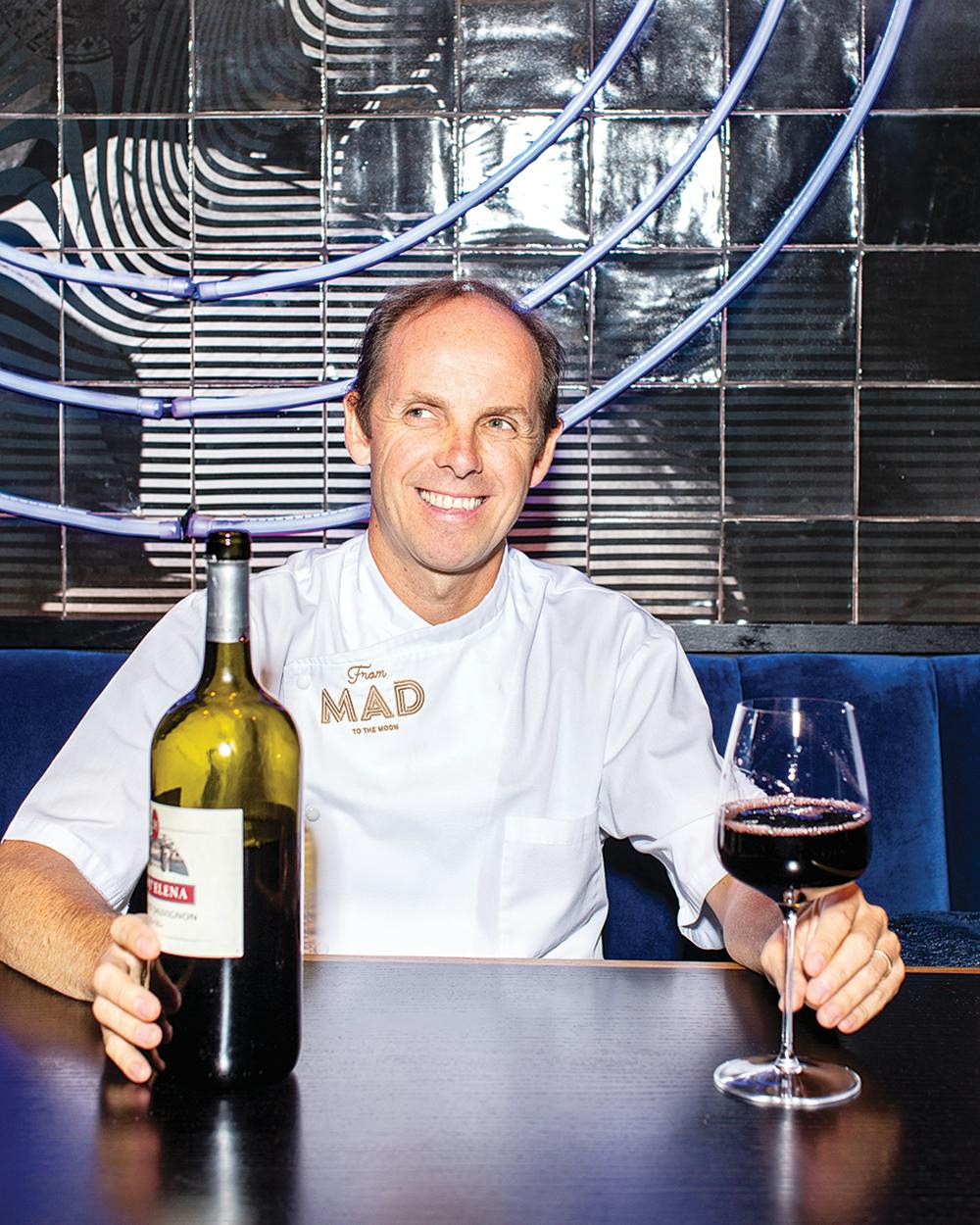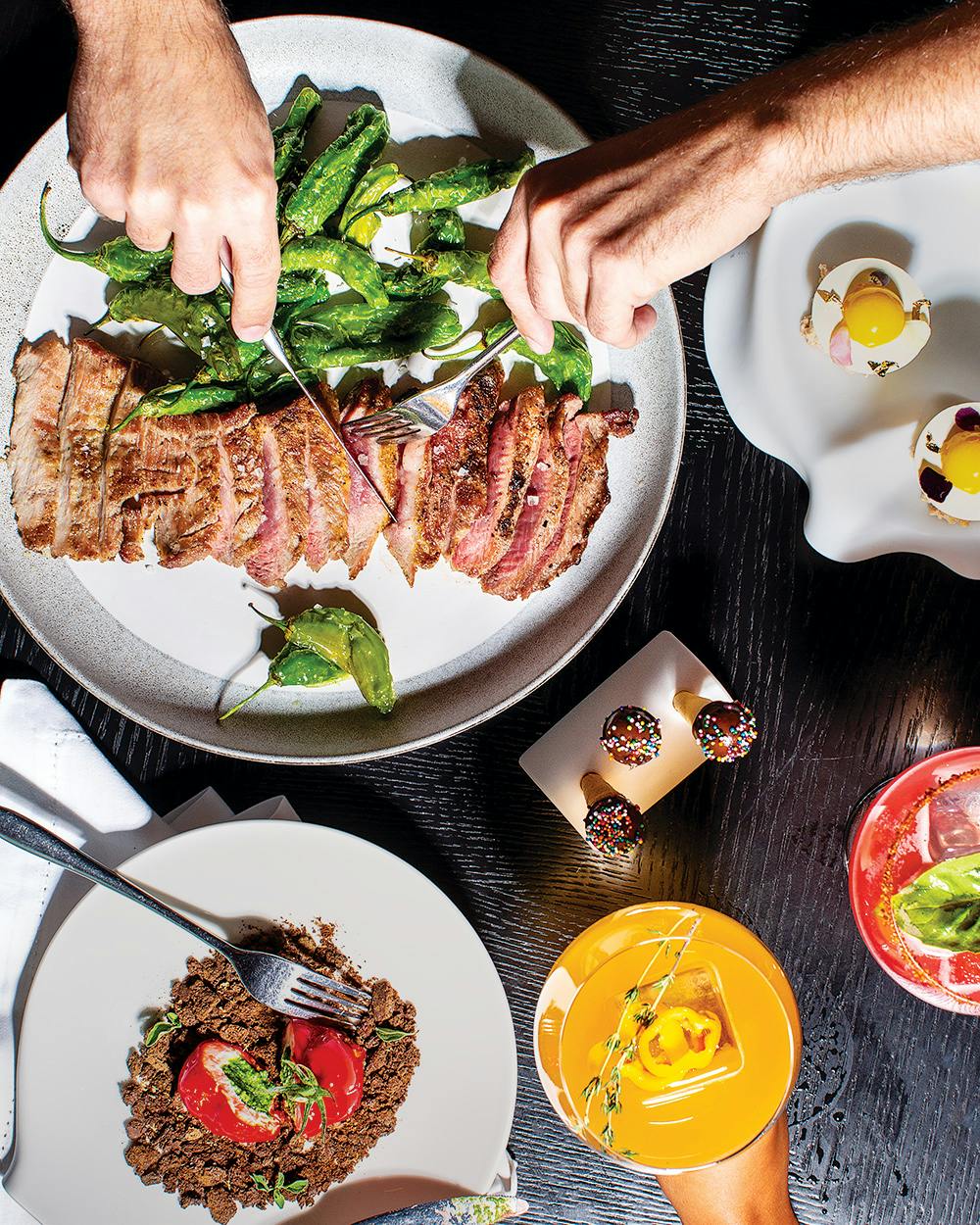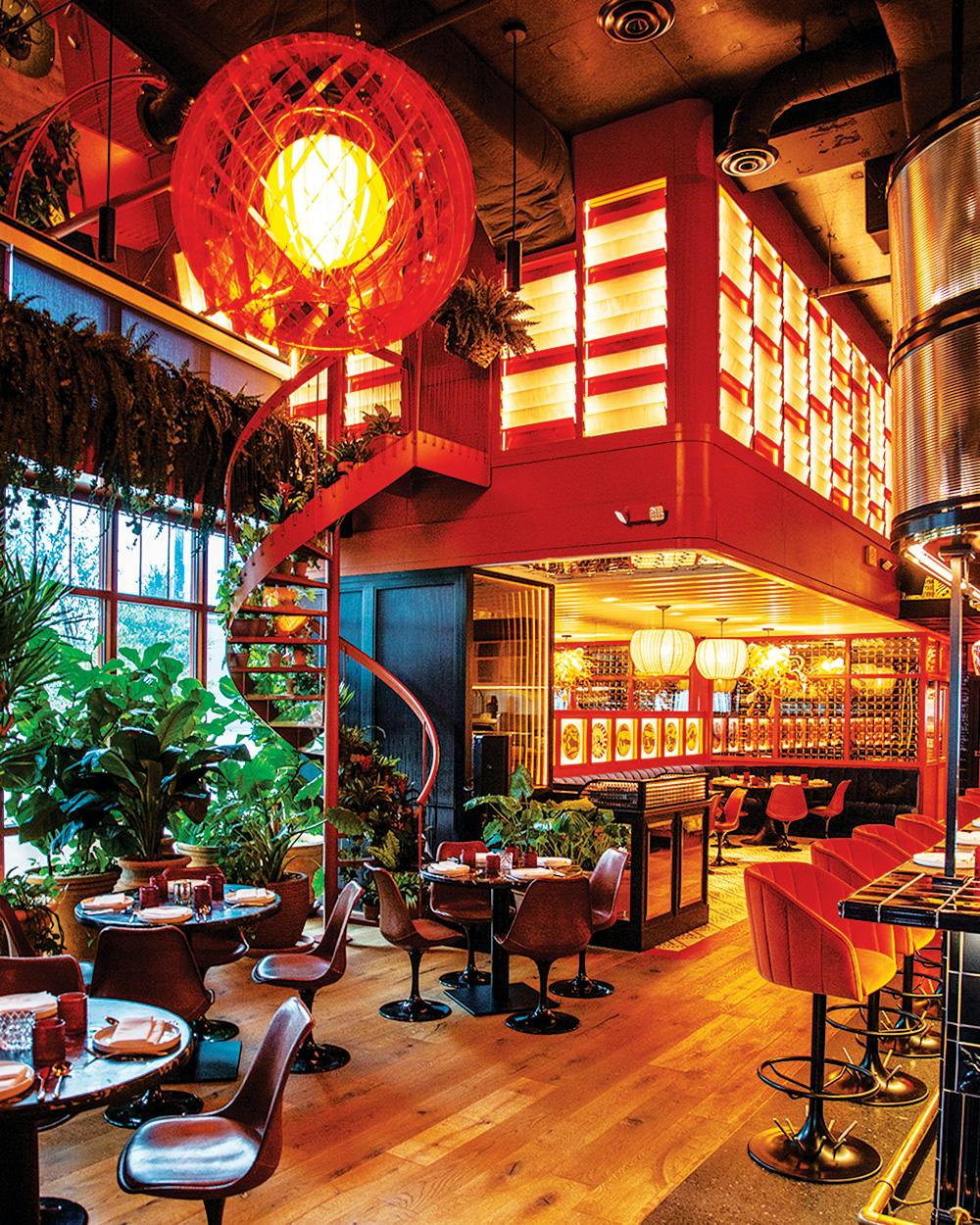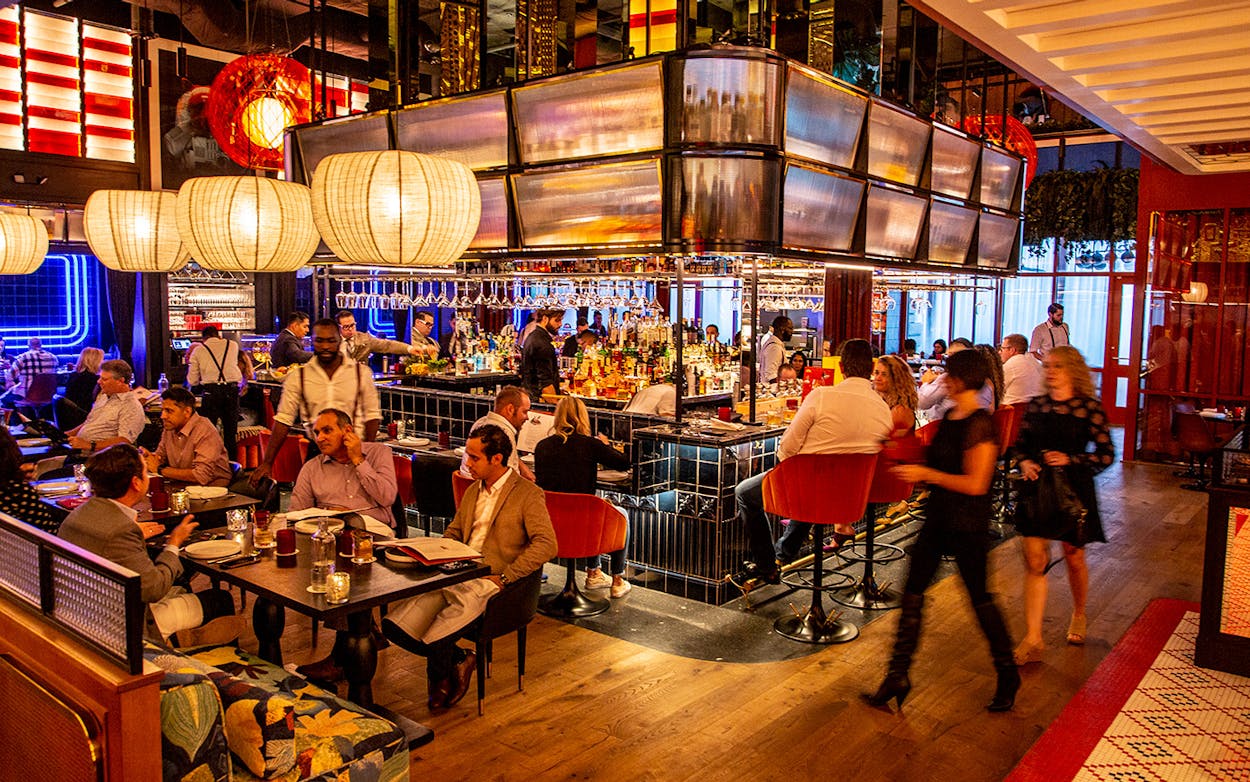Three friends and I stood transfixed at the entrance to MAD, the dark and dreamlike Spanish restaurant in Houston’s posh River Oaks District shopping village, gaping as a dozen tall, skinny mirrors spun maniacally over the bar. We oohed over two miniature golden replicas of the Cassini spacecraft, exhibited like works of art. We aahed at patio chandeliers fashioned from softly glowing orbs that mimicked the phases of the moon. Looking around, we spied a print of a bear wearing a space suit. Then a display of original Picasso-designed dinner plates caught our attention, as did two more chandeliers, magnificent creations by famed glass artist Dale Chihuly that seemed to twist and seethe in the shadowy light. How can I put this, exactly? It was like attending a costume party at the Moulin Rouge on New Year’s Eve, hosted by Alice, of Wonderland fame. If anyone ever deserved a place on a list of masterminds behind the world’s most deliciously outrageous restaurants, it’s MAD interior designer Lázaro Rosa-Violán, of Barcelona.
“Wonderful, but what about the food?” I hear someone—maybe it’s you—shouting over the music. I’m so glad you asked, because decor and dining are parts of the same grand scheme here. But first, a little lineage. Five-month-old MAD is the second Houston restaurant from two expat Spaniards, businessman Ignacio Torras and chef Luis Roger. The duo rose to prominence in 2014 with the opening of lovely, sedate BCN Taste & Tradition, in Montrose. But by the time they dreamed up wild child MAD—the restaurants’ names are the codes for the airports serving Barcelona and Madrid, respectively—they were clearly ready to have some fun.

Even so, the two places are obviously kin. As at BCN, the core competence of MAD rests on sophisticated dishes like Segovian-style suckling pig and wood-grilled octopus. But what sets the newer restaurant apart are more casual elements like paellas and classic tapas, as well as a list of crazy “modern tapas” that seem to be inspired by the tenets of molecular gastronomy. In case you have forgotten, molecular gastronomy is the culinary movement that flourished in Spain and elsewhere in the nineties and aughts. It was famous, some would say infamous, for high tech and hijinks, and not coincidentally, Roger was part of it. For a few months in the late nineties, he worked at the movement’s Delphic oracle, El Bulli, two hours north of Barcelona. The cuisine’s precision, rigor, and experimentation profoundly affected the way he thought about food. “It changed my life,” he tells me in an awed voice when I call him later.
As it turns out, El Bulli made a lasting impression on me as well, because in 2010, I had the extreme good fortune of dining there. And that is why, when my friends and I finally stopped gawking at MAD’s dining room, I said, “We’ve got to start with the liquid olives,” i.e., the signature creation of El Bulli. We made the request, and our server returned shortly with a large white platter holding a branch from an olive tree, leaves and all. “Put an olive in your mouth, and bite down gently,” she instructed. We did, breaking into smiles as each sphere burst into a tiny fountain of pure Manzanilla olive juice. (The method behind this magic involves edible chemicals and considerable patience; if you’re curious, go to YouTube, and you’ll find numerous interviews with El Bulli chef Ferran Adrià, including a great one by Anthony Bourdain, on No Reservations.) Next up, we ordered the MAD Tomato and received what looked to be a ruby-red hothouse beauty. In fact, it was a tomato-flavored gelatin shell seductively filled with creamy Parmesan mousse and lovely green basil pesto.

It’s tempting to go down a rabbit hole and sample every molecular item on the menu. My friend David insisted we get the cucurucho de foie. On our visit, the dish arrived in the form of three utterly convincing chocolate-dipped ice cream cones, which were actually filled with a heady brandied foie gras torchon (the “chocolate”? Super-reduced duck consommé). Then Felicia and Geary suggested the cuttlefish-topped squid ink “chicharrones” made from rice flour, like puffy Asian-style shrimp chips. We all wanted MAD ’n Cheese, and we marveled at the transparent noodles made with a rich ham broth and gelatin (the latter is obviously an indispensable ingredient at the restaurant) mixed with cheddar and beef.
But man does not live by magic tricks alone. Roger makes a point of importing key Spanish food products, like sweet, acorn-fed jamón ibérico, simply the world’s greatest ham. Have it with tomato-rubbed pan de cristal (fluffy, exquisitely crunchy “glass bread,” also brought in from the home country). For another special dish, try the well-marbled cut of pork known as secreto ibérico; lightly sautéed, it pairs wonderfully with Roger’s pungent peppercorn sauce.
And as long as you’re honoring tradition, it’s imperative to have Spain’s most iconic dish, paella. At MAD it’s labeled “wood-roasted rice” so that the chef can sneak in a few heretical yet seasonal ingredients. Like what? Like bok choy with the duck leg confit. Or, in the seafood version, fresh spinach with the prawns and pristine chunks of monkfish. The socarrat, paella’s hard-to-achieve caramelized bottom crust, is splendid here.
On the other hand, if you want a taste of the all-too-real world of modern Spanish dining, check out the “gulas,” which the menu refers to as “baby eels.” I hadn’t seen this particular delicacy offered anywhere in decades, so I was interested to know more. Turns out that for years now, real juvenile eels—angulas—have become so absurdly expensive in Spain that everybody but the rich has taken to eating gulas, faux eels made from processed fish (just like fake crabmeat). Munching a mild, perfectly pleasant mouthful of cocktail-straw-size gulas tarted up with purple potato chips and a soft-cooked quail egg, I decided to regard them as industrial-scale molecular gastronomy run amok and move on.

By the time you get to dessert, you’ll find it too spans the spectrum. Churros con chocolate is a Spanish classic: a paper cone of light, fried dough sticks accompanied by a bowl of killer dark chocolate dipping sauce. Pretty huevos voladores take a high-fashion turn, though they reminded me more of miniature planet Saturns than the “flying eggs” the name denoted, with gold-leaf-dusted white chocolate rings surrounding passion-fruit-gelée-covered spheres of passion-fruit mousse.
When Torras and Roger decided to open MAD, they knew the safe thing, the easy thing, would be to repeat what they had done before. But they didn’t want to be safe; they wanted to take chances. The restaurant is a love letter to Space City—even its slogan is “From MAD to the Moon.” Their moon shot has been a spectacular success. As we finished our meal, we took one last look at the spinning mirrors, blew a kiss to the space-helmeted bear, and stepped out into the real world.
This article originally appeared in the December 2019 issue of Texas Monthly with the headline “The Surreal World.” Subscribe today.
MAD
4444 Westheimer Rd, Houston
281-888-2770
D Tue–Sat. $$$$
Opened June 19, 2019
- More About:
- Pat’s Pick
- Restaurant Reviews
- Houston









